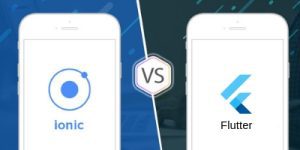Flutter mobile app development framework, first introduced by Google in May 2017 and its first stable release Flutter 1.0 was launched in Dec 2018. Due to its features, Flutter got enormous popularity around the world in a very short span of time. Flutter has revolutionized the way mobile apps are developed thereby making mobile app development faster and easier, which has been appealing to almost every mobile app developer. But, every new thing brings with it new challenges, and there is a lot you need to learn and understand about it. So, if you are also planning to create an app in Flutter, it is very important that first, you should understand it completely, and here is your complete guide to Flutter.
What is Flutter?
If I had to express Flutter in my words, I would say, it is the latest Hybrid mobile application environment functioning like native apps and Flutter is a first material design cross-platform developed by Google.
Flutter is an open source development environment embedded with a material design concept which gives the life to modern app designing with ease.
What is material design?
Material Design is a concept, which gives a magic wand in the hands of mobile application designers. With this, they can find a number of pre-built designs and modification functionalities. Google has included material design in flutter mobile app development platform to craft high-level UI experience in no time. This combination helps us to create a dynamic and stunning UI without many efforts.
Ionic Cordova V/s Flutter
Before Flutter, Cordova and PhoneGap were the platforms which filled the gap between Hybrid to native mobile applications. Basically, the Cordova framework uses the webview environment to create a native app. This framework has some device APIs to call native functions and uses HTML/CSS/JS to create a webview and wrap it to look like a native application. But, as Cordova uses Javascript it may create sluggish animations and poor UI response of the application.

However, this is not the case with Flutter. Unlike Cordova/Ionic, Flutter does not use HTML/CSS to create webviews, instead, it uses reactive views where we don’t need to take help of Javascript as a bridge to access native functionalities. Moreover, Flutter platform also gives us an opportunity to develop high performing IOS and Android application with a single code base. Flutter platform has a new architecture that includes widgets, and it is fast, customizable and extensible. Flutter does not use any platform widget (or DOM webviews), instead, it provides its own widgets, which serves as an advantage over Cordova/Ionic.
A place for big ideas.
Reimagine organizational performance while delivering a delightful experience through optimized operations.

Advantages of Flutter over Cordova/Ionic
1. Unlike Cordova/Ionic, which use webviews, it uses Widgets which have the fast rendering and also resolve the problem of poor UI performance. This is one of the major advantages of the Flutter app development platform because the webview components may not appear consistent on different devices or on different screen resolutions.
2. It provides hot reload feature in the development stage that means there is no need to re-install the application after making any changes.
3. Its dart package library provides firebase plugins, which are beneficial tools. Firebase also has its own features like live rendering(if any change is made in firebase db it will automatically reflect on the application) and it also provides fast database communication speed at the time of fetching/sending data.
Flutter FAQ
Can we attach a NodeJS server with flutter application and does it have performance difference while using Google firebase as backend?
Yes, we can attach an existing nodejs server with a Flutter app it will work similarly as Cordova/Flutter app or even better.
Undoubtedly, Google firebase is way faster backend, and it also has live reloading feature which makes it faster, but it is not a free tool, we have to pay some amount for its services and if you have an existing backend and don’t want to spend extra money on the additional backend. So, I will suggest you stick to the existing backend.
Is there any high standard PDF viewer available on flutter where we can put buttons on top of the document (to approve and reject) on both IOS/Android platforms? Does it show the PDFs from an URL after being authenticated?
Yes, Flutter has a PDF viewer which we can use to display PDFs after authentication and we can also give options to perform some actions.












